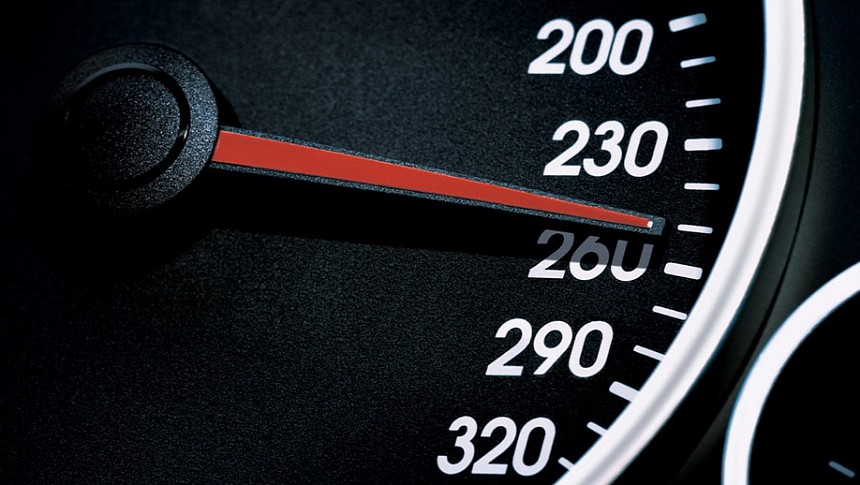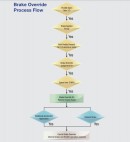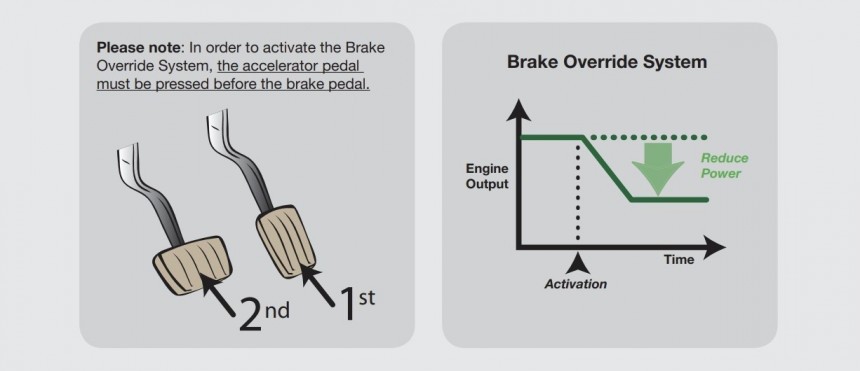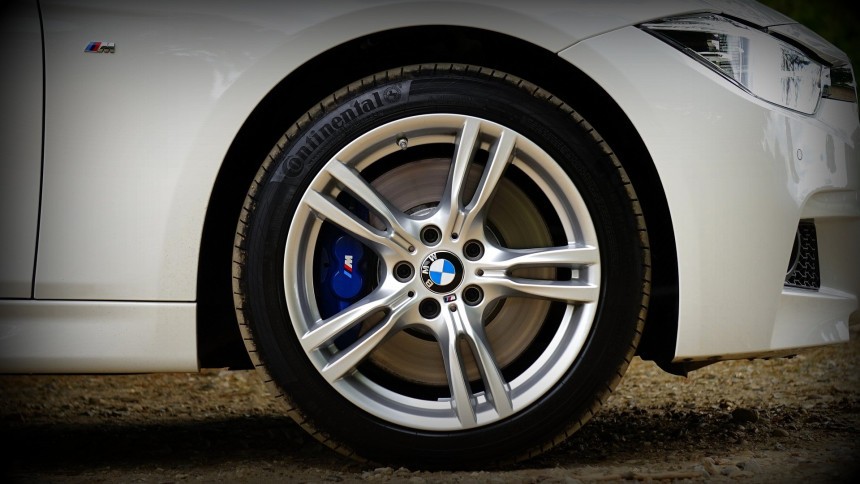Crumple zones, the collapsible steering column, airbags, three-point seatbelts, the seatbelt tensioner, anti-lock brakes, traction control, emergency automatic braking, and so many other features are taken for granted in modern cars. Another safety feature that doesn't get the recognition it deserves is the brake override system. But what is it, and how does it work?
Before going any further, we have to rewind back to August 2009. It all started with a man phoning 911, telling the operator that he couldn't get his 2009 model year Lexus ES 350 to stop due to a stuck accelerator pedal. Regardless of how much he pressed his right foot on the brake pedal, the car in question did not stop. The luxury-oriented sedan reportedly hit 120 miles per hour (nearly 200 kilometers per hour) at one point.
At higher-than-legal speed, the Lexus driver smashed into another vehicle on a San Diego freeway. The car eventually landed in a raving, killing all four inside. Two years and a month later, Toyota settled out of court with the family's relatives. An estimated 90 people died in Toyota and Lexus vehicles in similar fashion, and guess what? Come 2014, the company avoided prosecution for covering up information about this worrying issue by paying a whopping $1.2 billion.
Millions over millions of Toyota and Lexus vehicles were recalled. In addition to replacement accelerator pedals and floor mats, the Japanese manufacturer ultimately addressed the unintended acceleration problem by rolling out a software update. Said update is designed to override the accelerator when both the brake pedal and accelerator pedal are applied.
As you might have guessed by now, it's a bunch of code designed to prevent unintended acceleration events like the August 2009 case presented earlier. Had the aforementioned ES 350 been equipped with a manual transmission, the driver could have depressed the clutch, switched to neutral, and come to a stop. But alas, the ES 350 was exclusively offered with a torque-converter automatic (i.e., the Aisin U660E) back then.
How does the brake override system cut off engine power when simultaneously pressing both pedals? Software alone cannot do it without the help of a myriad of sensors, including speed sensors and the accelerator pedal position sensors. Even the brake light circuitry is taken into account. By cutting fuel off from the internal combustion engine, brake overriding brings engine speed down, therefore reducing vehicle speed.
It should be noted that B.O.S. does not reduce engine speed to zero revolutions per minute because a stalled engine equals no power steering. The brake override system activates only if the accelerator pedal is pressed before the brake pedal. Drivers are required to keep both pedals pressed for half a second, at speeds higher than 5 miles per hour (8 kilometers per hour).
Curiously enough, the answer is negative. After Toyota's unintended acceleration saga, pretty much all manufacturers out there took inspiration from the Japanese company to develop their own brake override systems. Back in May 2019, the National Highway Traffic Safety Administration explained that a mandate for brake-throttle override isn't necessary because – as just explained – everyone already uses B.O.S.
When safety boffins and consumers like you and me advocated for mandatory brake overriding back in 2012, the federal watchdog found that few automakers had committed to making this life-saving feature standard. In 2019, when Trump was calling the shots at the White House, the NHTSA discovered that every single automaker present in the United States of America had introduced brake override systems.
Light trucks (think Ford Maverick to the F-150), not only passenger vehicles and sport utility vehicles, also come standard with this feature. On the other hand, not mandating B.O.S. means that performance requirements vary from automaker to automaker. The NHTSA is only interested in the B.O.S. cutting fuel when both pedals are pressed simultaneously. As long as the vehicle coasts to a stop, we agree that performance requirements aren't really necessary.
B.O.S. has long been the specialty of German automakers. Prior to Toyota adopting it across its entire lineup, Chrysler group brands and Nissan also employed brake override systems in their vehicles. The safety feature was introduced into series production by Munich's favorite son in 1988. The V12-powered BMW 750i from the E32 generation, that is.
BMW rolled out B.O.S. to every single model line in 2001. Manual-equipped Bimmers also use it, and the software is written in such a way that brake overriding doesn't activate during heel-and-toe downshift in preparation for cornering.
Although the brake override system is of no use in cases of butter-fingered drivers confusing the brake pedal and loud pedal, the feature is extremely useful. Especially in the aftermath of Toyota's unintended acceleration blunder, brake overriding has proven itself as an essential safety technology.
At higher-than-legal speed, the Lexus driver smashed into another vehicle on a San Diego freeway. The car eventually landed in a raving, killing all four inside. Two years and a month later, Toyota settled out of court with the family's relatives. An estimated 90 people died in Toyota and Lexus vehicles in similar fashion, and guess what? Come 2014, the company avoided prosecution for covering up information about this worrying issue by paying a whopping $1.2 billion.
Millions over millions of Toyota and Lexus vehicles were recalled. In addition to replacement accelerator pedals and floor mats, the Japanese manufacturer ultimately addressed the unintended acceleration problem by rolling out a software update. Said update is designed to override the accelerator when both the brake pedal and accelerator pedal are applied.
What is a brake override system?
How does the brake override system cut off engine power when simultaneously pressing both pedals? Software alone cannot do it without the help of a myriad of sensors, including speed sensors and the accelerator pedal position sensors. Even the brake light circuitry is taken into account. By cutting fuel off from the internal combustion engine, brake overriding brings engine speed down, therefore reducing vehicle speed.
It should be noted that B.O.S. does not reduce engine speed to zero revolutions per minute because a stalled engine equals no power steering. The brake override system activates only if the accelerator pedal is pressed before the brake pedal. Drivers are required to keep both pedals pressed for half a second, at speeds higher than 5 miles per hour (8 kilometers per hour).
Is B.O.S. mandatory in new vehicles?
When safety boffins and consumers like you and me advocated for mandatory brake overriding back in 2012, the federal watchdog found that few automakers had committed to making this life-saving feature standard. In 2019, when Trump was calling the shots at the White House, the NHTSA discovered that every single automaker present in the United States of America had introduced brake override systems.
Light trucks (think Ford Maverick to the F-150), not only passenger vehicles and sport utility vehicles, also come standard with this feature. On the other hand, not mandating B.O.S. means that performance requirements vary from automaker to automaker. The NHTSA is only interested in the B.O.S. cutting fuel when both pedals are pressed simultaneously. As long as the vehicle coasts to a stop, we agree that performance requirements aren't really necessary.
Brake override systems from other automakers
BMW rolled out B.O.S. to every single model line in 2001. Manual-equipped Bimmers also use it, and the software is written in such a way that brake overriding doesn't activate during heel-and-toe downshift in preparation for cornering.
Although the brake override system is of no use in cases of butter-fingered drivers confusing the brake pedal and loud pedal, the feature is extremely useful. Especially in the aftermath of Toyota's unintended acceleration blunder, brake overriding has proven itself as an essential safety technology.










